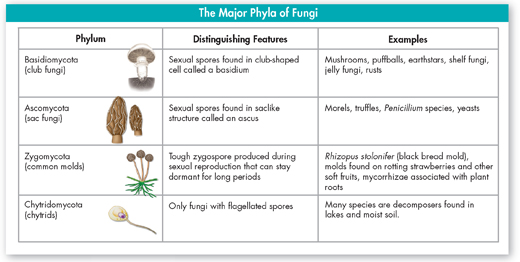Reproduction Fungi can reproduce asexually, primarily by releasing spores that are adapted to travel through air and water. Simply breaking off a hypha or budding off a cell can also serve as asexual reproduction.
Most fungi also can reproduce sexually. Figure 21–17 shows the life cycle of a type of bread mold, a fungus called Rhizopus stolonifer. Sexual reproduction in fungi often involves two different mating types. In Rhizopus, as in most fungi, gametes of both mating types are about the same size and are not usually called male and female. Instead, one mating type is called “+” (plus) and the other “–” (minus). When hyphae of opposite mating types meet, they start the process of sexual reproduction by fusing, bringing + and–nuclei together in the same cell. The + and–nuclei form pairs that divide in unison as the mycelium grows. Many of the paired nuclei fuse to form diploid zygote nuclei, which go through meiosis to make haploid spores. Each spore has a different combination of parental genes, and each can make a new mycelium.
Diversity of Fungi More than 100,000 species of fungi are known. Of course, they all share the characteristics that define them as fungi, but they differ from one another in important ways. Biologists have used these similarities and differences, along with DNA comparisons, to place the fungi into several distinct groups. The major groups of fungi differ from one another in their reproductive structures, as summarized in Figure 21–18.
MYSTERY CLUE

The cell walls of the hyphae found in diseased potatoes contain a lot of cellulose but no chitin. The nuclei in the cells are diploid. Does this evidence still point to a fungus culprit? Why or why not?
For more on the diversity of protists, go to the Visual Guide.  DOL•20–DOL•26
DOL•20–DOL•26

FIGURE 21–18 The Major Phyla of Fungi The table summarizes the main differences among the four major phyla of fungi. Infer Would you expect to find chytrids in aquatic or terrestrial habitats? Explain your answer.
dTable of Contents
- Formulas and Equations
- Applying Formulas and Equations
- Mean, Median, and Mode
- Estimation
- Using Measurements in Calculations
- Effects of Measurement Errors
- Accuracy
- Precision
- Comparing Accuracy and Precision
- Significant Figures
- Calculating With Significant Figures
- Scientific Notation
- Calculating With Scientific Notation
- Dimensional Analysis
- Applying Dimensional Analysis




